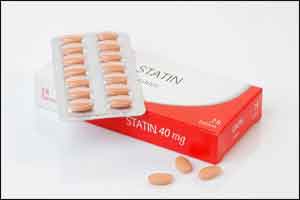- Home
- Editorial
- News
- Practice Guidelines
- Anesthesiology Guidelines
- Cancer Guidelines
- Cardiac Sciences Guidelines
- Critical Care Guidelines
- Dentistry Guidelines
- Dermatology Guidelines
- Diabetes and Endo Guidelines
- Diagnostics Guidelines
- ENT Guidelines
- Featured Practice Guidelines
- Gastroenterology Guidelines
- Geriatrics Guidelines
- Medicine Guidelines
- Nephrology Guidelines
- Neurosciences Guidelines
- Obs and Gynae Guidelines
- Ophthalmology Guidelines
- Orthopaedics Guidelines
- Paediatrics Guidelines
- Psychiatry Guidelines
- Pulmonology Guidelines
- Radiology Guidelines
- Surgery Guidelines
- Urology Guidelines
Statin-associated myalgia does not impair aerobic exercise performance in statin users

Denmark: Patients with statin-associated myalgia, or muscle pain, do not experience impaired aerobic exercise performance or muscle strength compared to statin users who do not experience muscle pain, finds a recent study published in the journal Medicine & Science in Sports & Exercise.
Statins, or HMG-CoA-reductase inhibitors, are cholesterol-lowering drugs widely used in both primary and secondary prevention of cardiovascular disease (CVD). Muscle pain is the most common adverse effect reported with the use of statins.
Thomas Morville, Faculty of Health Sciences, University of Copenhagen, Copenhagen, Denmark, and colleagues investigated whether statin-associated muscle pain impairs aerobic exercise performance including impaired muscle strength and fat oxidation.
For the LIFESTAT Study, the researchers performed a population-based survey on 600 people to assess the prevalence of statin-associated myalgia in the Danish population. In addition, the researchers also enrolled 64 statin users in primary prevention with myalgia (M; n= 25; 61 ± 1 yr) or without myalgia (NM; n = 37; 63 ± 1 yr) as well as a control group not taking statins (C; n = 20; 60 ± 2 yr) in a cross-sectional study where they performed aerobic exercise and muscle strength tests.
Also Read: Statins as add on treatment may help reduce symptoms of depression, finds study
Key findings of the study include:
- The response rate for the survey was 51% and data showed a prevalence of statin-associated myalgia in 19% of responders using statins.
- The experimental study showed no difference between the groups in aerobic capacity (C, 29 ± 1 mL O2·min−1·kg−1; M, 27 ± 1 mL O2·min−1·kg−1; NM, 28 ± 1 mL O2·min−1·kg−1) or maximal fat oxidation (C, 247 ± 26 mg·min−1; M, 295 ± 24 mg·min−1; NM, 279 ± 17 mg·min−1).
- Measurements of strength were similar in all three groups including rate of force development (C, 795 ± 56 N·m·s−1; M, 930 ± 93 N·m·s−1; NM, 971 ± 57 N·m·s−1) and leg extension power (C: 2.6 ± 0.2; M: 2.3 ± 0.1; NM: 2.4 ± 0.1 W·kg−1).
Also Read: Adding Ezetimibe to Simvastatin enhances CVD risk reduction in high risk diabetes patients
"Our findings have shown a 19% prevalence of statin-associated myalgia in the population using statins and that the odds ratio of myalgia was increased when the responders were physically active," concluded the authors.
To read the complete study log on to doi:10.1249/MSS.0000000000001920

Disclaimer: This site is primarily intended for healthcare professionals. Any content/information on this website does not replace the advice of medical and/or health professionals and should not be construed as medical/diagnostic advice/endorsement or prescription. Use of this site is subject to our terms of use, privacy policy, advertisement policy. © 2020 Minerva Medical Treatment Pvt Ltd